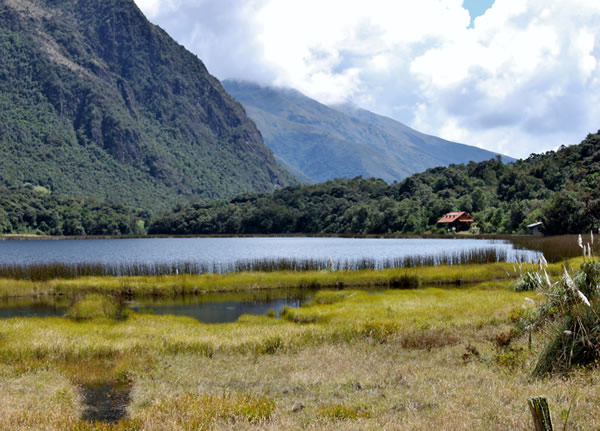 |
| Tundra and High-Altitude Biomes |
Regions where no trees grow because of frozen soil or extreme water runoff due to steep grades (at high altitudes) are known as tundra. High altitude biomes have similar limitations on the growth of plant life.
Tundra landscapes appear where long, cold winters, a permanently frozen subsoil, and strong winds combine to prevent the development of trees. The resulting landscapes tend to be vast plains with low-growing forbs and stunted shrubs.
Vast areas of this biome encircle the northernmost portions of North America and Eurasia, constituting the Arctic tundra. Climatic conditions atop high mountains at all latitudes are similar; these small, isolated areas are called the alpine tundra.
  |
Permafrost
The low temperatures of the tundra regions cause the formation of a permanently frozen layer of soil known as permafrost. Characteristic of Arctic tundra, permafrost, which varies in depth according to latitude, thaws at the surface during the brief summers. As the permafrost below is impenetrable by both water and plant roots, it is a major factor in determining the basic nature of tundra.
The alternate freezing and thawing of soil above the permafrost creates a symmetrical patterning of the land surface characteristic of Arctic tundra.
Perhaps the best known features of the landscape are stone polygons that result when frost pushes larger rocks toward the periphery, with smaller ones occupying the center of each unit. This alteration of the tundra landscape, called cryoplanation, is the major force in molding Arctic tundra landscapes.
In contrast, alpine tundra generally has little or no permafrost. Even though alpine precipitation is almost always higher than for Arctic tundra, steep grades result in a rapid runoff of water. Alpine soils are, therefore, much drier, except in the flat alpine meadows and bogs, where conditions are more like those of Arctic areas.
Vegetation
 |
| Alaskan tundra in autumn |
Both Arctic and alpine tundra regions are composed of plants that have adapted to the same generally stressful conditions.
Biodiversity of both plants and animals—the total number of species present—is low compared to most other ecosystems. Plant growth is slow because of the short growing seasons and the influence of permafrost.
Most tundra plants are low-growing perennials that reproduce vegetatively rather than by seed. Often they grow in the crevices of rocks that both shelter them in the winter and reflect heat onto them in summer.
Common plants of the low-lying Arctic tundra sites include various sedges, especially cotton grass, and sphagnum moss. On better-drained sites, biodiversity is higher, and various mosses, lichens, sedges, rush species, and herbs grow among dwarfed heath shrubs and willow. The arrangement of plants within a small area reflects the numerous micro climates resulting from the peculiar surface features.
   |
Alpine plants possess many of the features of Arctic plants. However, because strong winds are such a prominent feature of the alpine environment, most of the plants grow flat on the ground, forming mats or cushions.
Below alpine tundra and south of Arctic tundra, there is the boreal (also known as taiga) biome, dominated by coniferous forest. Between the forest and tundra lies a transitional zone, or ecotone. This ecotone is characterized by trees existing at their northern (or upper) limit.
Especially in alpine regions, stunted, gnarled trees occupy an area called krummholz. In North America, the krummholz is much more prominent in the Appalachian Mountains of New England than in the western mountains.
Conservation
Like all world biomes, tundra regions are subject to degradation and destruction, especially as a result of human activities. Because of low human population density and their unsuitability for agriculture, tundras generally are less impacted by humans than are grasslands and forests. However, tundra ecosystems, when disturbed, recover slowly, if at all.
As most tundra plants lack the ability to invade and colonize bare ground, the process of ecological succession that follows disturbances may take centuries. Even tire tracks left by vehicles can endure for decades. The melting of permafrost also has long-lasting effects.
The discovery of oil and gas in tundra regions, such as those of Alaska and Siberia, has greatly increased the potential for disturbances. Heavy equipment used to prospect for fossil fuels and to build roads and pipelines has caused great destruction of tundra ecosystems.
As the grasses and mosses are removed, the permafrost beneath melts, resulting in soil erosion. The disposal of sewage, solid wastes, and toxic chemicals poses special problems, as such pollutants tend to persist in the tundra environment longer than in warmer areas.
Animals of the Arctic tundra, such as caribou, have been hunted by the native Inuit, using traditional methods for centuries without an impact on populations. The introduction of such modern inventions as snow mobiles and rifles has caused a sharp decline in caribou numbers in some areas.
Although efforts at restoring other ecosystems, especially grasslands, have been quite successful, tundra restoration poses difficult problems. Seeding of disturbed Arctic tundra site swith native grasses is only marginally successful, even with the use of fertilizers.
In alpine tundra, restoration efforts have been somewhat more successful but involve transplanting as well as seeding and fertilizing. A recognition of natural successional patterns and long term monitoring is a necessity in such efforts.